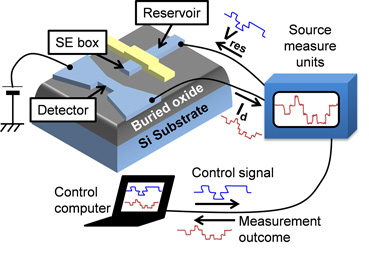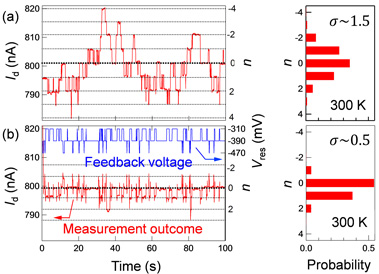Thermal-noise Suppression in Nano-scale Si Field-effect Transistors by Feedback Control of Single Electrons
Feedback control is a way to put target objects in desired conditions by controlling outputs based on measurement outcomes. For example, an air conditioner keeps a room temperature at a pleasant temperature by changing its output power based on the outcome of temperature measurements. The function cannot be achieved without proper measurement of the target object, the room temperature.
In this study, we performed feedback control on single electrons (SEs) using nano-scale Si field-effect transistors, which can detect SEs. Our device has an SE-resolution charge detector, an SE box, and an electron reservoir (Fig. 1). We can monitor the number n of SEs in the SE box by measuring current Id through the charge detector. Id fluctuates among discrete values with 5-nA intervals [Fig. 2(a)]. This fluctuation corresponds to the fluctuation of n caused by thermal motion of SEs between the SE box and electron reservoir [1]. Based on the measurement outcome of n, we changed the voltage Vres applied to the electron reservoir to fix n as a value (here, we define the value as n = 0): we changed Vres to -310 mV when n > 0, -470 mV when n < 0, and -390 mV when n = 0. The feedback control modifies the rate at which an SE enters to the SE box: when n > 0 (n < 0), the rate is decreased (increased) to reduce (increase) possibility of an increase in n. As a result, we achieved about a 60% reduction in the thermal fluctuation of n; variance σ of n is reduced from 1.5 to 0.5 [Fig. 2(b)] [2]. Feedback control of SEs can be used to correct errors at the SE level for achieving current standards with SE pumps, and to realize Maxwell’s demon in electrical devices [3].
This work was partially supported by the Funding Program for Next Generation World-Leading Researchers of JSPS.
- [1] K. Nishiguchi, Y. Ono, and A. Fujiwara, Nanotechnology 25, 275201 (2014).
- [2] K. Chida et al., Appl. Phys. Lett. 107, 073110 (2015).
- [3] J. V. Koski et al., Proc. Natl. Acad. Sci. U.S.A. 38, 13786 (2014); Phys. Rev. Lett. 115, 260602 (2015).

|

|
| Fig. 1. Schematics of feedback control of SEs. Number n of SEs in the SE box is monitored with current Id through the detector (red line). Voltage Vres applied to the electron reservoir was modulated based on the n measurement outcome (blue line). | Fig. 2. Thermal-noise suppression with feedback control. (a) Thermal fluctuation of n monitored with Id without feedback control. (b) Suppressed thermal fluctuation with feedback control. Vres (blue line) was modulated based on Id (red line). |